On and Off the Hill
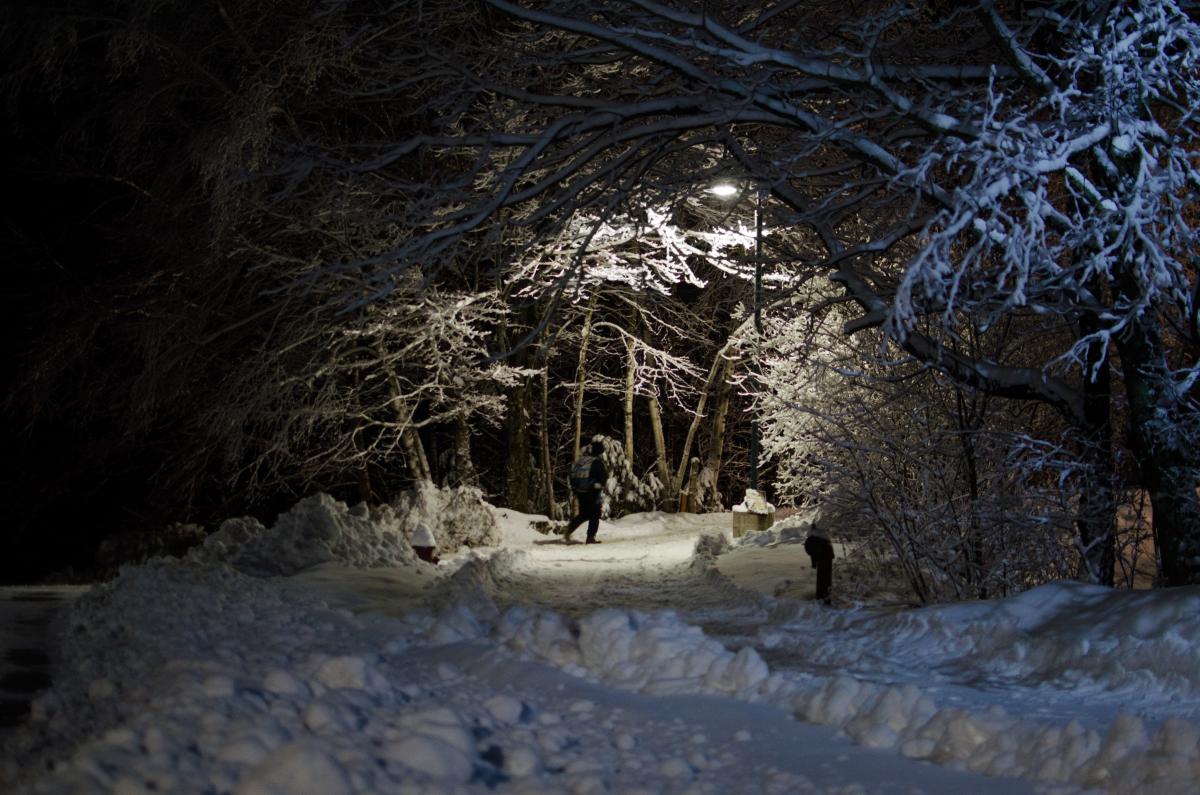
New Students Build Community Skills
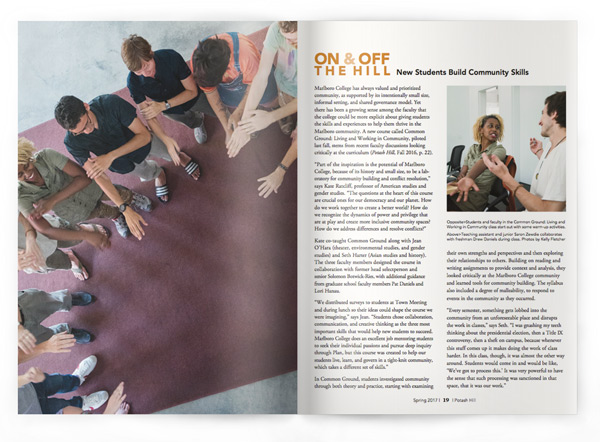
Marlboro College has always valued and prioritized community, as supported by its intentionally small size, informal setting, and shared governance model. Yet there has been a growing sense among the faculty that the college could be more explicit about giving students the skills and experiences to help them thrive in the Marlboro community. A new course called Common Ground: Living and Working in Community, piloted last fall, stems from recent faculty discussions looking critically at the curriculum (Potash Hill, Fall 2016).
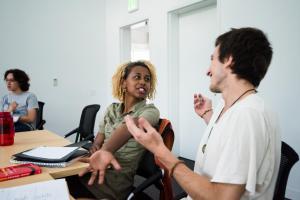 “Part of the inspiration is the potential of Marlboro College, because of its history and small size, to be a laboratory for community building and conflict resolution,” says Kate Ratcliff, professor of American studies and gender studies. “The questions at the heart of this course are crucial ones for our democracy and our planet. How do we work together to create a better world? How do we recognize the dynamics of power and privilege that are at play and create more inclusive community spaces? How do we address differences and resolve conflicts?”
“Part of the inspiration is the potential of Marlboro College, because of its history and small size, to be a laboratory for community building and conflict resolution,” says Kate Ratcliff, professor of American studies and gender studies. “The questions at the heart of this course are crucial ones for our democracy and our planet. How do we work together to create a better world? How do we recognize the dynamics of power and privilege that are at play and create more inclusive community spaces? How do we address differences and resolve conflicts?”
Kate co-taught Common Ground along with Jean O’Hara (theater, environmental studies, and gender studies) and Seth Harter (Asian studies and history). The three faculty members designed the course in collaboration with former head selectperson and senior Solomon Botwick-Ries, with additional guidance from graduate school faculty members Pat Daniels and Lori Hanau.
“We distributed surveys to students at Town Meeting and during lunch so their ideas could shape the course we were imagining,” says Jean. “Students chose collaboration, communication, and creative thinking as the three most important skills that would help new students to succeed. Marlboro College does an excellent job mentoring students to seek their individual passions and pursue deep inquiry through Plan, but this course was created to help our students live, learn, and govern in a tight-knit community, which takes a different set of skills.”
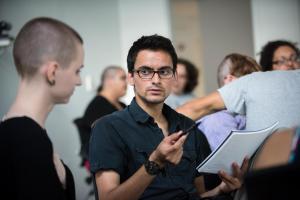 In Common Ground, students investigated community through both theory and practice, starting with examining their own strengths and perspectives and then exploring their relationships to others. Building on reading and writing assignments to provide context and analysis, they looked critically at the Marlboro College community and learned tools for community building. The syllabus also included a degree of malleability, to respond to events in the community as they occurred.
In Common Ground, students investigated community through both theory and practice, starting with examining their own strengths and perspectives and then exploring their relationships to others. Building on reading and writing assignments to provide context and analysis, they looked critically at the Marlboro College community and learned tools for community building. The syllabus also included a degree of malleability, to respond to events in the community as they occurred.
“Every semester, something gets lobbed into the community from an unforeseeable place and disrupts the work in classes,” says Seth. “I was gnashing my teeth thinking about the presidential election, then a Title IX controversy, then a theft on campus, because whenever this stuff comes up it makes doing the work of class harder. In this class, though, it was almost the other way around. Students would come in and would be like, ‘We’ve got to process this.’ It was very powerful to have the sense that such processing was sanctioned in that space, that it was our work.”
This work included President Kevin coming to class for a debriefing about the presidential election, a conversation that affected everyone deeply. It also contributed to a communique from Kevin to the college community about not tolerating xenophobia on campus.
“It was powerful for students to see the president show up to class and then immediately respond,” says Jean. “That they felt comfortable sharing honestly, despite him coming in, also speaks to the amount of work we did as a group. They understood that these conversations have to happen with everybody, not just in this classroom. This isn’t a rehearsal.”
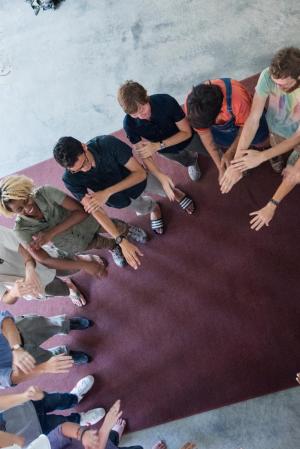 “As we developed trust among the micro-community of the class, we began to cultivate a warm, inviting atmosphere,” says Solomon Botwick-Reis, who also acted as one of three teaching assistants. “The course was a transformative space of tenderness—tender vulnerability with each other, with issues in the Marlboro community, and with the broader realities of our nation and world.”
“As we developed trust among the micro-community of the class, we began to cultivate a warm, inviting atmosphere,” says Solomon Botwick-Reis, who also acted as one of three teaching assistants. “The course was a transformative space of tenderness—tender vulnerability with each other, with issues in the Marlboro community, and with the broader realities of our nation and world.”
Students put theory into practice in the form of community-based projects that they designed and co-created, building on the sense of reciprocity and responsibility essential to community. These projects focused on issues around classism at Marlboro, public education about smoking, and helping art students to cover materials costs.
“I began to grasp the extent to which Marlboro students can impact their campus community,” says freshman Adeel Sultan, whose group piloted a Creative Arts Co-op where students can sell their art and help other students afford art supplies. “Coming out of that experience, I feel empowered and ready to collaborate with others on future projects that benefit the community.”
“Students learned a lot about the challenges of working together, and came to a new appreciation of the difficulty of organizing and publicizing events on campus—all of that I think was a real eye-opener to them,” says Seth. “Their project equipped students with the knowledge they need, and the tools they need, to be better community members. This included an appreciation for the work of staff, and seeing that their roles are very complicated.”
“The highlight of the class for me was the intentional way we created a community in the class itself,” says Kate. “Peter Block [author of Community: The Structure of Belonging] emphasizes the idea that community is not something that exists in a pre-formed way, but is more a way of being with ourselves and each other to create change. I was profoundly moved by the work we did together in the classroom.”
Jennifer Girouard Brings It All Back to Marlboro
“My experience at Marlboro was very intense, in a good way,” says Jennifer Girouard, who graduated in 2001 with a Plan of Concentration exploring the sociology of white-collar labor. A first-generation college student, Jennifer didn’t know what to expect, so she threw herself into the Marlboro experience full steam. “I didn’t actually know what sociology was—they didn’t teach it at my high school, so I had no idea—I just got swept into it,” she says. Now, 15 years later, Jennifer is on the other side of that intense experience, as Marlboro’s new sociology professor.
“Sociology is such a broad field,” says Jennifer, reflecting on how she first gravitated toward the discipline. “It was a lens to understand the world in a new way, and to understand my own life trajectory. I think what’s always interesting for students is when they understand some of the large structural forces and start to put together pieces of ‘how did I end up here?’ Seeing that bigger picture is very useful for me. I got sucked into viewing the world through that lens, and I didn’t leave it.”
Jennifer received her doctorate in sociology from Brandeis University, but before continuing on to graduate school she spent five years working with children at a homeless shelter in Massachusetts and for Head Start in Appalachian Ohio. In the latter, she worked one-on-one with preschoolers and their families to build new skills, broaden early development experiences, and monitor their progress.
“Only when I was thinking of coming back to Marlboro did I realize that these meetings were like doing little family tutorials, sitting together and working through what was important to them,” says Jennifer. “These experiences challenged and immersed me in new social and cultural milieu, and honed my sociological lens.”
Jennifer’s doctoral dissertation, titled “When Law Comes to Town: Participation and Discourse in Fair-Share Affordable Housing Hearings,” was based on a study of four towns’ implementation of a state affordable-housing law. She was particularly interested in tracking the discourse of small-scale public hearings where everyone got together and talked—or yelled—about an issue, a forum with interesting similarities to Marlboro’s Town Meetings. Jennifer is co-editor of Varieties of Civic Innovation: Deliberative, Collaborative, Network, and Narrative Approaches.
Jennifer says that many of the things that drew her in as a Marlboro student continue to inspire her as a professor. She started teaching in the fall already aware that Marlboro’s professors are constantly being challenged and pushed to new subjects by students, to a degree rarely found at other institutions.
“When a student comes to me with an interest, I get to expand and learn alongside them. Having been a student, I understood that this was part of the job, and that’s what excited me to come back. I’m currently working with a student on immigration in Sweden. I don’t know anything about that, but now I get to learn it, and it benefits me, the student, and other students that come after.”
With a discipline as broad-ranging as sociology—essentially the study of the social world—Jennifer expects many fascinating diversions driven by student interest. She’s also eager to provide opportunities for students to participate in her ongoing research, exploring competing structures and cultural discourse through local land-use conflicts.
“I’m always interested in how we construct and contest space and land use, and I’m sure there are a lot of really interesting ways to build on that here,” Jennifer says. “I’m very interested in how we view and regulate different housing types, such as trailer parks, which here in Vermont were the hardest hit by Tropical Storm Irene.”
Jennifer recognizes that she is rejoining Marlboro at a really interesting transitional time period. There’s a lot of new energy coming in with students, and there’s a shift in faculty—with concomitant discussions of changes in the curriculum. She is excited to see what comes of these conversations, but thinks there are some core things that won’t change.
“Marlboro does so well at preparing students to think richly, deeply about the world. I was just telling Jerry [Levy, sociology professor emeritus] that when I started my doctoral program without a master’s degree, I felt completely prepared. Marlboro doesn’t prepare students for specific jobs or different career paths, but it shapes their minds in ways that are very effective, if hard to measure.”
Partner Colleges Come to Campus
In October, Marlboro College co-hosted the annual meeting for the Consortium for Innovative Environments in Learning (CIEL), a working group of 12 institutions founded on innovative and student-centered practices in higher education. A group of more than 30 colleagues from partner colleges across the country convened at Marlboro to meet with President Kevin and discuss shared governance and community engagement on campus.
“All of our CIEL partners excel in different ways to produce life-long learners and engaged citizens, but Marlboro has a unique history of leadership in the area of shared governance,” said Richard Glejzer, dean of faculty. “Together we discussed curricular initiatives and decision-making models that prepare students for a lifetime of community engagement, service, and stewardship.”
“In class, I might be Solomon’s boss, but on select board, he’s my boss,” said mathematics professor and select board member Matt Ollis, referring to head selectperson Solomon Botwick-Ries. “Except for the fact that neither is an especially boss-like relationship.” The session was followed by a reception and dinner in the campus center, where participants discussed new developments at partner institutions Green Mountain College and University of Maine at Farmington.
The CIEL meeting was cohosted by Bennington College, which offered workshops on intellectual mentorship and experiential learning. Bennington President Mariko Silver hosted a lunch discussion about equity and inclusion and the impact of recent events on aspects of civility and community on campus.
Dual Graduates Go for the Whole Marlboro
“My first residency weekend had me experiencing deja vu,” said Heidi Doyle ’94 MAT ’16 in her student address at commencement last May, referring to her experience in the graduate program. “The discussions that took place, the rigor of the work, and the self-pacing that was required seemed strangely familiar. . . I was beginning to have a sneaking suspicion that the undergraduate and the graduate campuses valued the same things.”
Heidi was the first “dual” alumnus to address the first-ever combined undergraduate-graduate commencement (Potash Hill, Fall 2016), and she gave a fitting tribute to what is a growing phenomenon. Marlboro students are finding valuable continuities and rewarding careers by following their undergraduate degree with one of the college’s graduate programs.
“Nearly 30 students, with several more on the way, have completed both their bachelor’s and master’s degrees at Marlboro, bringing theory into practice through a graduate program in teaching or management,” says Kate Jellema, associate dean for graduate and professional studies. “We have much to learn from these ‘bi-lumni,’ and their positive stories are even more poignant as we move the graduate program to Potash Hill this year."
“The two programs have so much in common: extraordinary faculty, small classes, emphasis on community, and the opportunity for each student to study and pursue what he or she is most passionate about,” says Sarah Swift ’04, who completed her Capstone for an MS in Management in December. Sarah’s Plan in sociology and photography focused on the social and psychological aspects of dying and grieving, including making photographic quilts with people facing end-of-life issues. For her Capstone she established a nonprofit called Sewing Our Stories.
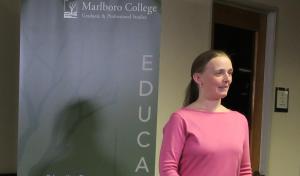 “I felt drawn to figuring out how to develop a nonprofit that could use traditional crafts, such as the photographic quilting I’d done for my Plan, with people at the end of life as a way to honor and affirm their lives,” says Sarah, who works at a hospice council in Augusta, Maine. “In a way, my graduate Capstone felt like an extension of my Plan— with the support of my coursework and faculty adviser, I was able to develop and launch this nonprofit project.”
“I felt drawn to figuring out how to develop a nonprofit that could use traditional crafts, such as the photographic quilting I’d done for my Plan, with people at the end of life as a way to honor and affirm their lives,” says Sarah, who works at a hospice council in Augusta, Maine. “In a way, my graduate Capstone felt like an extension of my Plan— with the support of my coursework and faculty adviser, I was able to develop and launch this nonprofit project.”
Adam Katrick ’07 did his Plan in biology and writing, specifically wolf biology, and last fall completed his MS in Management with a concentration in nonprofit management. In the process he has started his own nonprofit to teach people in the region about wolves, called Wolfgard Northeast, and is embarking on a campaign to build a wolf center in Southern Vermont.
“We’ve got a really dynamic, energized board of directors, a number of dedicated supporters, and have run programs from New York City to Burlington and many places in between,” says Adam, who lives in Marlboro. “Every week I get the opportunity to teach people about wolves. I’m more immersed in my relationship with the wilderness and wolves than ever before. It’s such a joy to see people’s faces when I tell them we’re building a wolf center—there’s so much excitement there.”
“I found that having gone through the Plan process made the Capstone project at the end of my graduate program far less intimidating,” says Francisco Mugnani ’10 MAT ’14. Francisco’s Plan in film/video studies focused on examining patterns in the narrative structure of hero myths, and his Capstone involved creating an online course to learn video production. “In both projects I worked one-on-one with a professor, set goals, and worked toward a project that exhibited my learning. The Capstone was different, however, in that the focus was more on applying my learning to help another person or organization.”
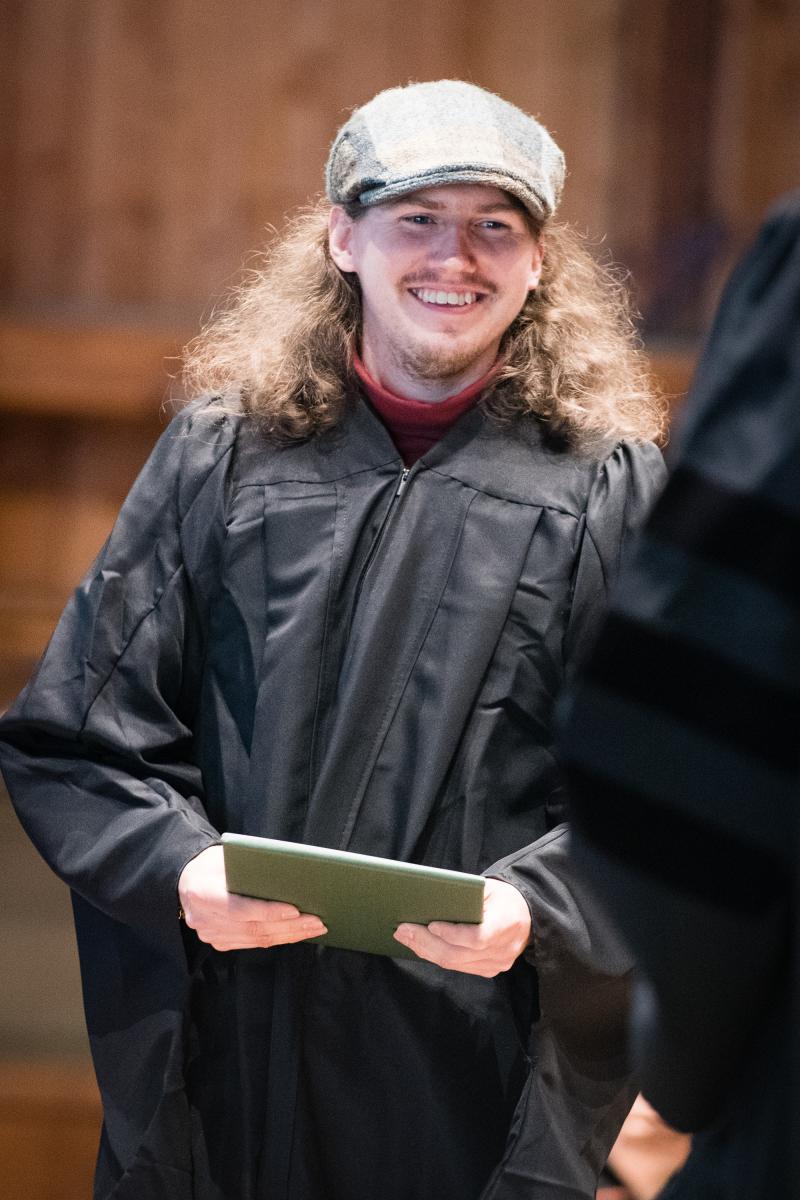 Francisco has gone on to work as a media producer and teacher, giving film instruction and helping out with several independent video projects, most often in schools. He is currently working at the Brooks Memorial Library in Brattleboro. “I delight in helping kids find their books and in witnessing firsthand how the library is working to evolve with emerging technologies and new ideas about how people learn,” he says.
Francisco has gone on to work as a media producer and teacher, giving film instruction and helping out with several independent video projects, most often in schools. He is currently working at the Brooks Memorial Library in Brattleboro. “I delight in helping kids find their books and in witnessing firsthand how the library is working to evolve with emerging technologies and new ideas about how people learn,” he says.
Geordie Morse ’13 MATESOL ’16 did his Plan on Asian studies and education, specifically on issues concerning the contemporary Japanese education system, such as how history textbooks influenced, and were influenced by, modern politics and culture. After graduating from Marlboro he spent a year gaining valuable firsthand experience as an English teacher in Japan, then returned to get his MA in TESOL.
“I wanted to continue my studies in an institution that shared Marlboro’s ideals and ethics of education,” says Geordie. “I was looking for small class sizes and a program that made my contributions feel worthwhile. What stands out to me about the graduate program is how dedicated and passionate the professors are about the mission of their programs, and how much care and attention they are willing to give their students to help them succeed.”
“My favorite thing about the graduate program was the conversations during the face-to-face weekends,” says Heidi Doyle, who is now a library media and technology integration specialist at Sunapee Central Elementary School in New Hampshire. “Because all of my classmates came from such diverse backgrounds, they brought a unique perspective to the conversation. We were all trying to accomplish the same goals, but our purpose and intent for those goals were vastly different.”
Like many “bi-lumni,” Heidi found similarities between her undergraduate and graduate experiences, including the rigor of work, the quality of discussion, and a certain “quirkiness.” “Small class sizes and intimate relationships with classmates and professors is prevalent in both programs. Those relationships enrich both your professional and personal life and provide a safe environment for taking risks.”
Or in Francisco’s apt words, “If you think of Marlboro undergrad as a movie, the Marlboro graduate program is like a great sequel. It preserves many of the core elements that made the original successful, but expands it in a bold new direction.”
Although not technically a dual alumnus, Ahmed Salama drives home the idea that there is something synergistic in Marlboro’s undergraduate and graduate programs. A native of Egypt, Ahmed taught Arabic to undergraduate students as Marlboro’s Fulbright Fellow for Arabic Language in the 2008–2009 academic year. After working for several years as head of the foreign languages department at Learning Services and Solutions Center in El Mahalla El Kubra, Egypt, Ahmed was back at Marlboro last summer, participating in the MA in TESOL program.
Storied Faculty Members Move On
Three of Marlboro’s most senior faculty will be retiring this academic year, after a combined 134 years of dedicated service to the college and mentorship to countless adoring students. The college made the decision to remove a retirement benefit introduced in 2007, for budgetary reasons, and T. Wilson (literature and writing), Geraldine Pitmann de Batlle (literature), and Stan Charkey (music) elected to take the benefit before it disappeared.
 “How does one describe the singular, formative love between teacher and student?” asks Amanda DeBisschop ’10, who was one of T.’s Plan students and is now a teacher herself at Leland & Gray High School in Townshend, Vermont. We’re not sure we have the answer, but we figure that former students of these formidable faculty members will be in the best position to take a stab at it.
“How does one describe the singular, formative love between teacher and student?” asks Amanda DeBisschop ’10, who was one of T.’s Plan students and is now a teacher herself at Leland & Gray High School in Townshend, Vermont. We’re not sure we have the answer, but we figure that former students of these formidable faculty members will be in the best position to take a stab at it.
Amanda continues, “From the first, I knew that I wanted to know T. Hunter Wilson. I felt soon after seeing him on campus, at Town Meeting, that there was something I had to learn from him. And what I learned was the incredible feeling of someone taking my writing seriously. In my entire life, there had been no one to assess my work on an academic level. He helped me to feel credible. He treated my work as though it were a contribution to the larger world of poetry. He also taught me the value of accountability in a partnership, both as a student and doubly as a teacher, now, of my own students.”
T. first taught writing and literature at Marlboro in 1968, after receiving his MFA from the University of Iowa Writers’ Workshop, and in addition to teaching he has done stints as dean of faculty and, twice, as director of the World Studies Program. Always engaged in the campus community, he has served as Town Meeting moderator, Community Court justice, and member of countless committees.
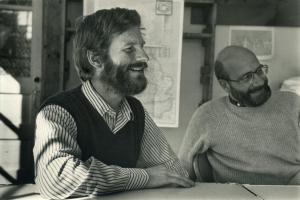 “I still, 40-plus years later, vividly remember the eagerness with which I looked forward to our meetings,” says Kathryn Kramer ’75, now a published author and professor of literature at Middlebury College. “I could have listened from dawn till dusk to T. talking about my manuscript. This kind of attention, this kind of uninflected reading, is an enormous gift to a young writer, and I have remembered that experience over the years as I’ve gone on to teach writing myself.”
“I still, 40-plus years later, vividly remember the eagerness with which I looked forward to our meetings,” says Kathryn Kramer ’75, now a published author and professor of literature at Middlebury College. “I could have listened from dawn till dusk to T. talking about my manuscript. This kind of attention, this kind of uninflected reading, is an enormous gift to a young writer, and I have remembered that experience over the years as I’ve gone on to teach writing myself.”
“I think the best thing about working with T. was that he really did let you come to conclusions on your own,” says Cate Marvin ’93, now a published poet and professor of creative writing and literature at Colby College. “In this respect, he was very patient. He also acknowledged the hard work of writing. One week I turned in 11 poems, but they were all bad. And T. told me that the fact I’d written that many poems and didn’t give up was a better sign than if the poems had been good. So he taught me the notion of perseverance.”
“T. is a brilliant teacher and editor, and he made me feel brilliant, too,” said Molly Booth ’14, whose Plan project was the young adult novel Saving Hamlet, published by Disney Hyperion last November. “I left his office charged with energy, and annoyed with the 20 steps it took to get to the library, where I could sit down and write. With T., I learned how to write and edit, how to develop characters, how to listen to my creative gut . . . everything we did together applies to what I do now. When I feel uncertain in my writing, I return my mind to Marlboro, and think what discussion T. and I would be having about this word, or that character.”
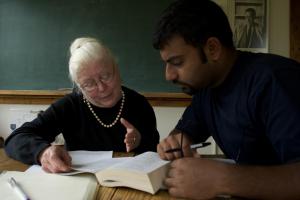 Nearly as senior as T. is Geraldine Pittman de Batlle, who joined Marlboro in 1969 after advanced graduate study at Southern Illinois University and Columbia University. Known for her passion for literature ranging from English Romantic poetry to modern fiction, Geri won the adoration of students who enjoyed working closely with her on projects of mutual interest.
Nearly as senior as T. is Geraldine Pittman de Batlle, who joined Marlboro in 1969 after advanced graduate study at Southern Illinois University and Columbia University. Known for her passion for literature ranging from English Romantic poetry to modern fiction, Geri won the adoration of students who enjoyed working closely with her on projects of mutual interest.
“Geri conveyed a love of literature that was infectious,” says Chris Davey ’93, a freelance editor who says he daily applies the skills she taught. “Her request that students show attentiveness to and respect for words struck me as profoundly ethical, as a call to bear witness to the power of words and the effects of that power, to recognize the ways great literature enacts empathy, and then to go beyond, to seek to hear for oneself ‘the grass grow and the squirrel’s heart beat,’ to brave ‘the roar which lies on the other side of silence.’”
“The amount of writing I had to do for Geri was intense,” says Ron Mwangaguhunga ’94, now a working writer and editor in New York City with a novel on the way. “Good or bad thoughts, Geri wanted me to get them on paper just to get in the practice of regular writing. Her patience, compassion, and, above all, demand for excellence—and always, always, more writing— helped me massively with the work I do today.”
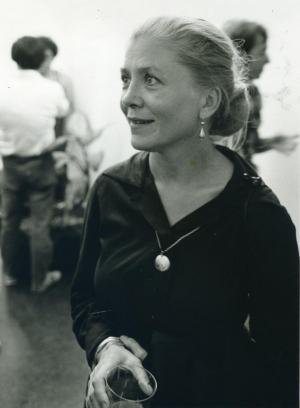 “I was always happy working with Geri,” says Sue Crimmins ’89, now a landscape designer. “I saw her every day, and we made each other smile. Even on those days that I had not finished even a paragraph of my Plan, she held me as closely as any member of her family. We would sit right down next to each other and plow through all the words and all the sentences and all the paragraphs, clarifying every idea. She was my teacher, but also a good friend, and my strictest tutor. I am still sorting my ideas, and words, and reaching for clarity in everything I do.”
“I was always happy working with Geri,” says Sue Crimmins ’89, now a landscape designer. “I saw her every day, and we made each other smile. Even on those days that I had not finished even a paragraph of my Plan, she held me as closely as any member of her family. We would sit right down next to each other and plow through all the words and all the sentences and all the paragraphs, clarifying every idea. She was my teacher, but also a good friend, and my strictest tutor. I am still sorting my ideas, and words, and reaching for clarity in everything I do.”
“Geri has tremendous respect and patience for literature,” says Ryan Stratton ’11, who works as an admissions counselor at Marlboro. “I think that one of the best lessons I learned from Geri was reverence—in a contemporary world where irony is used as social and intellectual capital, I think it was a humbling experience to really sit down and listen to what Dante was trying to say about self-growth and love for others. Geri had a reputation for being a tough teacher—I would say that she has only the highest expectations for her students, because she knows them and has faith in them, and wants them to reach their fullest potential.”
Music professor Stan Charkey, the Luis C. Batlle Chair in Music, has taught music at Marlboro since 1977, when he received his Master of Music degree from the University of Massachusetts. A composer and performer of note, Stan had premieres of new works performed in Paris, Los Angeles, Washington, and of course Marlboro.
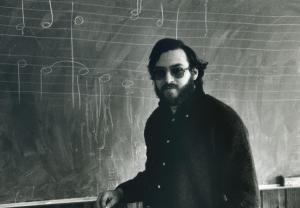 “I appreciated that Stan held his students to high standards, but always allowed us the space to pursue our interests independently,” says Allen Magana ’13, a graduate student in Latin American and Iberian studies at the University of California, Santa Barbara. “He respected us as scholars and never expected anything less from our work. Stan offered me the opportunity to prove to myself that I have the ability to complete top-level scholarship. This experience gave me the confidence to continue to pursue academic research, and I hope someday to foster this same love of scholarship in my own students.”
“I appreciated that Stan held his students to high standards, but always allowed us the space to pursue our interests independently,” says Allen Magana ’13, a graduate student in Latin American and Iberian studies at the University of California, Santa Barbara. “He respected us as scholars and never expected anything less from our work. Stan offered me the opportunity to prove to myself that I have the ability to complete top-level scholarship. This experience gave me the confidence to continue to pursue academic research, and I hope someday to foster this same love of scholarship in my own students.”
“My favorite part about working with Stan is that he was extremely open-minded to my ideas as a composer,” says Felix Jarrar ’16, already an accomplished composer and pianist in the New York area. “During my lessons with him, he would always give me constructive feedback on how my musical gestures would or wouldn’t work toward my larger musical goals. He had a lot of really great suggestions for pieces to listen to if I found myself ‘stuck.’ My work with Stan has helped me immensely since leaving Marlboro. When I write music, I use all of the contrapuntal and compositional skills he taught me.”
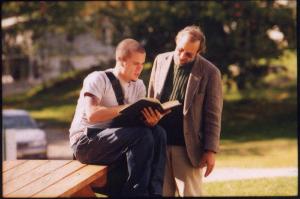 “Stan’s regard for a student was, for me, ideal,” says Peter Blanchette ’92, a musician, composer, and founder of the Happy Valley Guitar Orchestra. “He neither pampered you through the maddeningly tricky counterpoint exercises, nor disrespected your earnest effort. On the other hand, he would expose the weaknesses in your results with firmness, followed by excellent suggestions of how to improve. He taught me more about what makes great music tick than anyone else in my life, and every single day that I work, I apply musical understanding that he brought into my life.”
“Stan’s regard for a student was, for me, ideal,” says Peter Blanchette ’92, a musician, composer, and founder of the Happy Valley Guitar Orchestra. “He neither pampered you through the maddeningly tricky counterpoint exercises, nor disrespected your earnest effort. On the other hand, he would expose the weaknesses in your results with firmness, followed by excellent suggestions of how to improve. He taught me more about what makes great music tick than anyone else in my life, and every single day that I work, I apply musical understanding that he brought into my life.”
“He was always ready to put some beautifully intricate piece in front of us and have at it,” says Mike Harrist ’10, a professional musician and music teacher in Boston. “His joy in reading and playing is deep and infectious. Looking back, I’ve learned many lessons just from this one aspect of our time together. Joy in making music and a realistic perspective on one’s ability are not antithetical. Holding both together fuels improvement and leads to a grounded musicality. Stan’s teaching and high standards continue to inspire me to be a better musician and more rigorous thinker.”
One of Amanda DeBisschop’s fondest memories is when she joined T. Wilson to hear poet Gary Snyder, one of his mentors, and they approached Gary after the reading. When Gary said to T., “Shouldn’t you be close to retiring now?” Amanda piped in, “He can’t retire. I wouldn’t know what to do.”
All in the college community share Amanda’s sentiments about T., and feel just the same about Geri and Stan, but acknowledge that this is a shortsighted response. Amanda concurs: “I simply want every other Marlboro student to have access to the person who taught me the most valuable things that I know: to be a conscious part of a community, to write as though my life depends on it (and it does), and to do good work.”
Also of Note
Woodrow Wilson Fellow Marcia Grant (pictured right) was on campus for a week in October to engage in all things Marlboro, from attending Town Meeting to visiting classes both on Potash Hill and at the graduate campus. Marcia is currently provost of the American University in Paris, and has a distinguished career in global higher education, including serving in institutions in Africa, the Middle East, and South Asia. While at Marlboro she made presentations to the campus community on international careers, favorite books, and the global impact of liberal arts education.
In November, MA in Teaching with Technology student Jasmin Bey Cowin was elected president of the Rotary Club of New York #6, where she has been active for 10 years. Guided by her passion for “education as the tool for transformative empowerment and a pathway to a fulfilling life,” Jasmin will coordinate the club’s community, city, and international service projects. An accomplished educator herself, she holds both a master’s and doctorate in education from Teachers College at Columbia University.
In October, Stephanie Sopka joined the campus as technical services librarian. “I like getting to see all of the books that come in,” says Stephanie. She came to Marlboro from the University of Illinois at Urbana-Champaign, where she completed her MS in library and information science and worked in the university law library. “I have spent a lot of time studying feminist theory and queer theory, so I’m excited to expand our collection in these areas, and to support students and faculty in their work.”
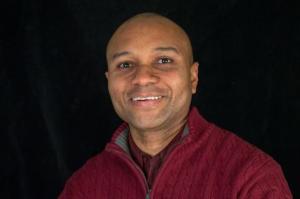 “There are those who have access to technology, but they don’t have the knowledge and skills to use this technology to support learning in school,” said Emmanual Ajanma (pictured right) during his Capstone presentation about bringing Google Apps to a school in Nigeria. Emmanual was one of 10 students in the MAT, MSM, and MBA programs who presented their Capstones in November. Other presenters included Dhruv Jagasia on developing a socially-conscious eyewear brand and Missy Munoz on promoting sustainable building standards for low-income housing. See an excerpt.
“There are those who have access to technology, but they don’t have the knowledge and skills to use this technology to support learning in school,” said Emmanual Ajanma (pictured right) during his Capstone presentation about bringing Google Apps to a school in Nigeria. Emmanual was one of 10 students in the MAT, MSM, and MBA programs who presented their Capstones in November. Other presenters included Dhruv Jagasia on developing a socially-conscious eyewear brand and Missy Munoz on promoting sustainable building standards for low-income housing. See an excerpt.
Marlboro College made the short list for “10 colleges where joining student clubs is easy” released in February by U.S. News and World Report. Drawn from U.S. News’ survey of more than 1,800 colleges and universities nationally, Marlboro is the only New England college in the top 10 and tied second with Hamilton College in New York State. Marlboro was rated as having 6.1 students per club, nine times the average among the 1,195 ranked schools that reported these data in an annual survey.
Sophomore Spencer Knickerbocker, student trails steward, was instrumental to the success of Trails Day 2016 in October, which drew 20 volunteers despite the cold, rainy weather. “I was pleasantly surprised by the great enthusiasm of volunteers and their willingness to work,” says Spencer, who spent four years training as a nordic skier and is delighted to discover Marlboro’s trails. “I have traveled around the world to the hotbeds of nordic sport, yet I never found a place with so many trail options as Marlboro.”
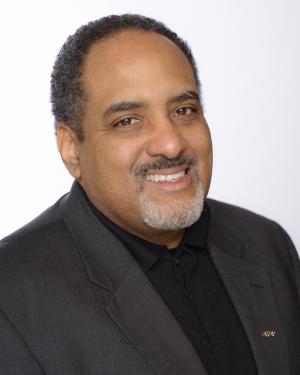 New graduate faculty member Kevin McQueen (pictured right) brings extensive experience in corporate finance, with a deep commitment to facilitating social change through mission-driven organizations. Marlboro College Graduate and Professional Studies was pleased to welcome Kevin and four other new faculty members recently, part of the ongoing development and enrichment of the management program. Kevin, Beth Tener, and Melinda Weekes-Laidlow joined Marlboro in the fall, each of them bringing new skills and expertise in corporate finance, collaborative leadership, and organizational development. This winter, Jude Smith Rachelle and Carol Stimmel joined the management faculty to co-teach an MBA seminar in Performance Measurement and Analytics. You can learn more about these new faculty members and their impressive backgrounds on the college website.
New graduate faculty member Kevin McQueen (pictured right) brings extensive experience in corporate finance, with a deep commitment to facilitating social change through mission-driven organizations. Marlboro College Graduate and Professional Studies was pleased to welcome Kevin and four other new faculty members recently, part of the ongoing development and enrichment of the management program. Kevin, Beth Tener, and Melinda Weekes-Laidlow joined Marlboro in the fall, each of them bringing new skills and expertise in corporate finance, collaborative leadership, and organizational development. This winter, Jude Smith Rachelle and Carol Stimmel joined the management faculty to co-teach an MBA seminar in Performance Measurement and Analytics. You can learn more about these new faculty members and their impressive backgrounds on the college website.
Last fall a team of undergraduate and graduate faculty, staff, and students made several visits to Ashoka Changemaker Campuses, including College of the Atlantic, College of Social Innovation, and Brown University. Along with a discussion at Town Meeting in September, these visits were important steps toward Marlboro College being recognized as a Changemaker Campus by Ashoka, a global organization that promotes positive change by supporting social innovation. “The team has been working hard over the last few months, and we’re eager to share our progress with you,” says Kelsa Summer ’13, a student in the MS in Management program. Learn more.
Community Spirit 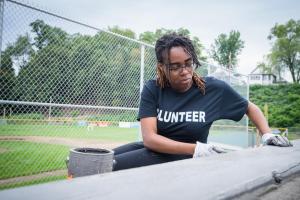 Freshman Cyane Thomas joined 14 other students, staff, and faculty in a United Way Day of Caring project, giving a fresh coat of paint to the local little league field, in September.
Freshman Cyane Thomas joined 14 other students, staff, and faculty in a United Way Day of Caring project, giving a fresh coat of paint to the local little league field, in September.
Most Important Meal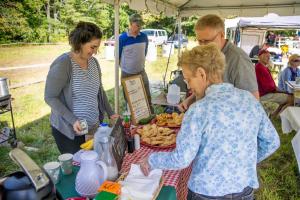 Junior Emily Motter and chemistry professor Todd Smith help serve up breakfast at the Marlboro Community Town Fair in September, raising money for the college farm.
Junior Emily Motter and chemistry professor Todd Smith help serve up breakfast at the Marlboro Community Town Fair in September, raising money for the college farm.
Getting Green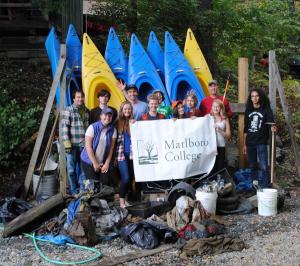 In October, members of the Environmental Studies Colloquium participated in a clean-up on the Connecticut River, finding many articles too gross to mention.
In October, members of the Environmental Studies Colloquium participated in a clean-up on the Connecticut River, finding many articles too gross to mention.
Learning to Spell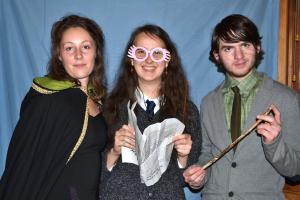 Senior Crystal Graybeal, junior Kristen Thompson, and sophomore Dan Medeiros strike a magical pose at the Hogwarts Dinner in October, which welcomed local families.
Senior Crystal Graybeal, junior Kristen Thompson, and sophomore Dan Medeiros strike a magical pose at the Hogwarts Dinner in October, which welcomed local families.
Events
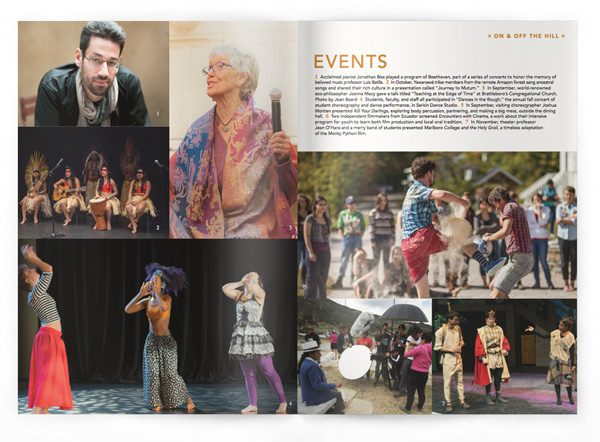
1 Acclaimed pianist Jonathan Biss played a program of Beethoven, part of a series of concerts to honor the memory of beloved music professor Luis Batlle. 2 In October, Yawanawá tribe members from the remote Amazon forest sang ancestral songs and shared their rich culture in a presentation called “Journey to Mutum.” 3 In September, world-renowned eco-philosopher Joanna Macy gave a talk titled “Teaching at the Edge of Time” at Brattleboro’s Congregational Church. Photo by Joan Beard 4 Students, faculty, and staff all participated in “Dances in the Rough,” the annual fall concert of student choreography and dance performance, in Serkin Dance Studio. 5 In September, visiting choreographer Joshua Monten presented Kill Your Darlings, exploring body percussion, partnering, and making a big mess, outside the dining hall. 6 Two independent filmmakers from Ecuador screened Encounters with Cinema, a work about their intensive program for youth to learn both film production and local oral tradition. 7 In November, theater professor Jean O’Hara and a merry band of students presented Marlboro College and the Holy Grail, a timeless adaptation of the Monty Python film.
Focus on Faculty
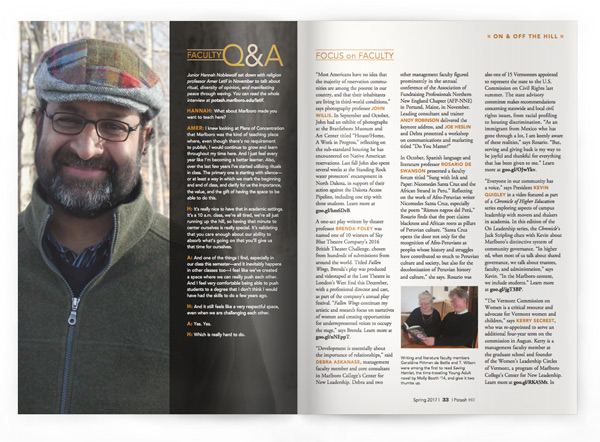
Faculty Q&A
Junior Hannah Noblewolf sat down with religion professor Amer Latif in November to talk about ritual, diversity of opinion, and manifesting peace through waving. You can read the whole interview.
Hannah: What about Marlboro made you want to teach here?
Amer: I knew looking at Plans of Concentration that Marlboro was the kind of teaching place where, even though there’s no requirement to publish, I would continue to grow and learn throughout my time here. And I just feel every year like I’m becoming a better learner. Also, over the last few years I’ve started utilizing rituals in class. The primary one is starting with silence— or at least a way in which we mark the beginning and end of class, and clarify for us the importance, the value, and the gift of having the space to be able to do this.
H: It’s really nice to have that in academic settings. It’s a 10 a.m. class, we’re all tired, we’re all just running up the hill, so having that minute to center ourselves is really special. It’s validating that you care enough about our ability to absorb what’s going on that you’ll give us that time for ourselves.
A: And one of the things I find, especially in our class this semester—and it inevitably happens in other classes too—I feel like we’ve created a space where we can really push each other. And I feel very comfortable being able to push students to a degree that I don’t think I would have had the skills to do a few years ago.
H: And it still feels like a very respectful space, even when we are challenging each other.
A: Yes. Yes.
H: Which is really hard to do. “
Focus on Faculty
Most Americans have no idea that the majority of reservation communities are among the poorest in our country, and that their inhabitants are living in third-world conditions,” says photography professor John Willis. In September and October, John had an exhibit of photographs at the Brattleboro Museum and Art Center titled “House/Home, A Work in Progress,” reflecting on the sub-standard housing he has encountered on Native American reservations. Last fall John also spent several weeks at the Standing Rock water protectors’ encampment in North Dakota, in support of their action against the Dakota Access Pipeline, including one trip with three students. Learn more.
A one-act play written by theater professor Brenda Foley was named one of 10 winners of Sky Blue Theatre Company’s 2016 British Theater Challenge, chosen from hundreds of submissions from around the world. Titled Fallen Wings, Brenda’s play was produced and videotaped at the Lost Theatre in London’s West End this December, with a professional director and cast, as part of the company’s annual play festival. “Fallen Wings continues my artistic and research focus on narratives of women and creating opportunities for underrepresented voices to occupy the stage,” says Brenda. Learn more.
“Development is essentially about the importance of relationships,” said Debra Askanase, management faculty member and core consultant in Marlboro College’s Center for New Leadership. Debra and two other management faculty figured prominently in the annual conference of the Association of Fundraising Professionals Northern New England Chapter (AFP-NNE) in Portand, Maine, in November. Leading consultant and trainer Andy Robinson delivered the keynote address, and Joe Heslin and Debra presented a workshop on communications and marketing titled “Do You Matter?”
In October, Spanish language and literature professor Rosario de Swanson presented a faculty forum titled “Sung with Ink and Paper: Nicomedes Santa Cruz and the African Strand in Peru.” Reflecting on the work of Afro-Peruvian writer Nicomedes Santa Cruz, especially the poem “Ritmos negros del Per.,” Rosario finds that the poet claims blackness and African roots as pillars of Peruvian culture. “Santa Cruz opens the door not only for the recognition of Afro-Peruvians as peoples whose history and struggles have contributed so much to Peruvian culture and society, but also for the decolonization of Peruvian history and culture,” she says. Rosario was also one of 15 Vermonters appointed to represent the state to the U.S. Commission on Civil Rights last summer. The state advisory committee makes recommendations concerning statewide and local civil rights issues, from racial profiling to housing discrimination. “As an immigrant from Mexico who has gone through a lot, I am keenly aware of these realities,” says Rosario. “But, serving and giving back is my way to be joyful and thankful for everything that has been given to me.” Learn more.
“Everyone in our community has a voice,” says President Kevin Quigley in a video featured as part of a Chronicle of Higher Education series exploring aspects of campus leadership with movers and shakers in academia. In this edition of the On Leadership series, the Chronicle’s Jack Stripling chats with Kevin about Marlboro’s distinctive system of community governance. “In higher ed, when most of us talk about shared governance, we talk about trustees, faculty, and administration,” says Kevin. “In the Marlboro context, we include students.” Learn more.
“The Vermont Commission on Women is a critical resource and advocate for Vermont women and children,” says Kerry Secrest, who was re-appointed to serve an additional four-year term on the commission in August. Kerry is a management faculty member at the graduate school and founder of the Women’s Leadership Circles of Vermont, a program of Marlboro College’s Center for New Leadership. Learn more. In January the college had a book release party for Kerry’s chapter in the new book Leading and Managing in the Social Sector, published by Springer International. Co-written with Marla Solomon, director of partnership programs for Five Colleges, the chapter is an analysis of the Women’s Leadership Circles of Vermont.
“The workshop table can feel like Thanksgiving with somebody else’s family, which welcomes you but laughs at jokes you don’t understand,” says writing professor John Sheehy. In January, John published an article in The Chronicle of Higher Education titled “Taking the Fight to the Page,” describing his experiences teaching the summer writing intensive that brings veterans and civilians together to write. “Between Hemingway and James we, soldiers and civilians, try to make truth out of stories, which are all we have to make it out of. We have things in common. We have all loved, we have all lost brothers, sisters—albeit some violently and far too young.”
In November, ceramics professor Roberto Lugo was one of 46 artists from across the U.S. to receive an unrestricted $50,000 fellowship from United States Artists. “This will significantly impact my work,” said Rob, who has received national attention for his work combining visual arts traditions and stimulating new conversations around cultural tolerance. “I will be able to create a new body of work and have the financial ability to work on aspects that were previously unavailable.” Learn more. Rob was also featured in Remezcla, in a profile by Michelle Threadgold ’07, and in a series of podcasts from craftschools.us.
Oxford Classics Fellow Isabella Grunberger-Kirsh presented a faculty forum in October titled “Ausonius the Loser: A Gaulish Poet on the Brink,” referring to the forgotten fourth-century poet of Bordeaux. While Ausonius’s oeuvre consists of self-pitying verses composed by a failed politician at the edge of the decaying Roman Empire, Ella’s talk aimed to restore some of the poet’s authorial dignity. “I explore the possibility that Ausonius knew precisely what he was doing in reinventing himself as a provincial loser,” she says. “His refusal to comment openly on the afflicted empire offers us an opportunity to view the fall of the Roman Empire from a fresh angle.”
In October, philosophy professor William Edelglass was elected to the board of directors of the International Association of Environmental Philosophy. His recent invited talks include “What Counts as Philosophy? Rationality and Practice in Buddhist Traditions” (Brooklyn College); “The Practice of Place: From Pilgrimage to Cosmopolitanism” (The Sitka Institute); “sKu rten: Painting and Sculpture as Religious Technologies in Tibetan Buddhism” (Barre Center for Buddhist Studies); and “Why the Bodhisattva Isn’t Satisfied: Buddhism, Happiness, and Ethics” (Smith College). Among other recent publications, William has a chapter on “Mindfulness and Moral Transformation: Awakening to Others in Śāntideva’s Ethics” in The Bloomsbury Handbook of Indian Ethics. He also continues to teach regularly at the Barre Center for Buddhist Studies in Barre, Massachusetts.
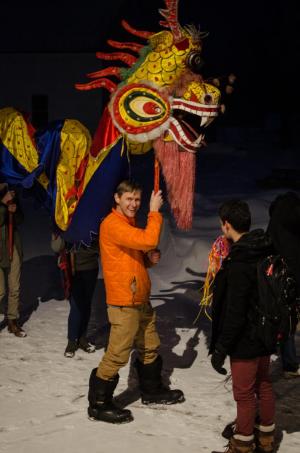 In October and November, art history professor Felicity Ratté presented a series of lectures at the Osher Lifelong Learning Institute in Dummerston, Vermont, on the art and architecture of the Islamic world. Titled “What Is Islamic Art?” and examining everything from the five pillars of Islam to modern adaptations of Islamic art, the series was designed as a way for non-Muslims to learn about Islamic culture and history.
In October and November, art history professor Felicity Ratté presented a series of lectures at the Osher Lifelong Learning Institute in Dummerston, Vermont, on the art and architecture of the Islamic world. Titled “What Is Islamic Art?” and examining everything from the five pillars of Islam to modern adaptations of Islamic art, the series was designed as a way for non-Muslims to learn about Islamic culture and history.
In November, art faculty members Tim Segar and Cathy Osman participated in a group exhibition at A.P.E. Gallery Northampton, Massachusetts, titled “Forget What I Said.” Also featuring the work of William Brayton, Brenda Garand, Carol Keller, Joe Smith, Deborra Stewart-Pettengill, and Erica Wurtz, artists who have known each other for many years, the show provided the opportunity to create a visual dialogue across the disciplines of collage, painting, and sculpture.
In June, history professor Adam Franklin-Lyons gave an invited talk at the Vermont Midsummer Medieval Summit at Norwich University, titled “Political Information and Communication in the Crown of Aragon: Collaboration & Control.” “By late in the 14th century, the kingdom of Valencia was woven together by a dense web of ambassadors and runners who could move information between cities and courts at surprising speed,” says Adam. “The level of formalized communication allowed for new practices of information dissemination, collaboration, and secrecy at multiple levels of government.”
Caleb Clark, faculty member and chair of the MA in Teaching with Technology program was chosen to participate in the Vermont Leadership Institute class of 2017. A program created by the Snelling Center for Government, VLI seeks out, honors, challenges, and develops a select group of Vermont citizens each year who have the potential to provide the leadership needed to address issues of statewide significance. Caleb is one of 24 fellows selected this year on the basis of their professional achievements, demonstrated interest in the community, and capacity for leadership.
In November, visiting French language professor Frederique Marty presented a faculty forum titled “Translation and Religious Propaganda in Renaissance Europe.” Frederique explored how the vernacular was used by the Jesuits to counter the rise of Protestantism, specifically to diffuse the story of the Virgin of Loreto and carve a space for Marian devotion in Europe and the New World. She argued that although Jesuit authors such as Orazio Torsellini in Italy and Louis Richeome in France have taken all the credit, the role of the anonymous translator cannot be underestimated.